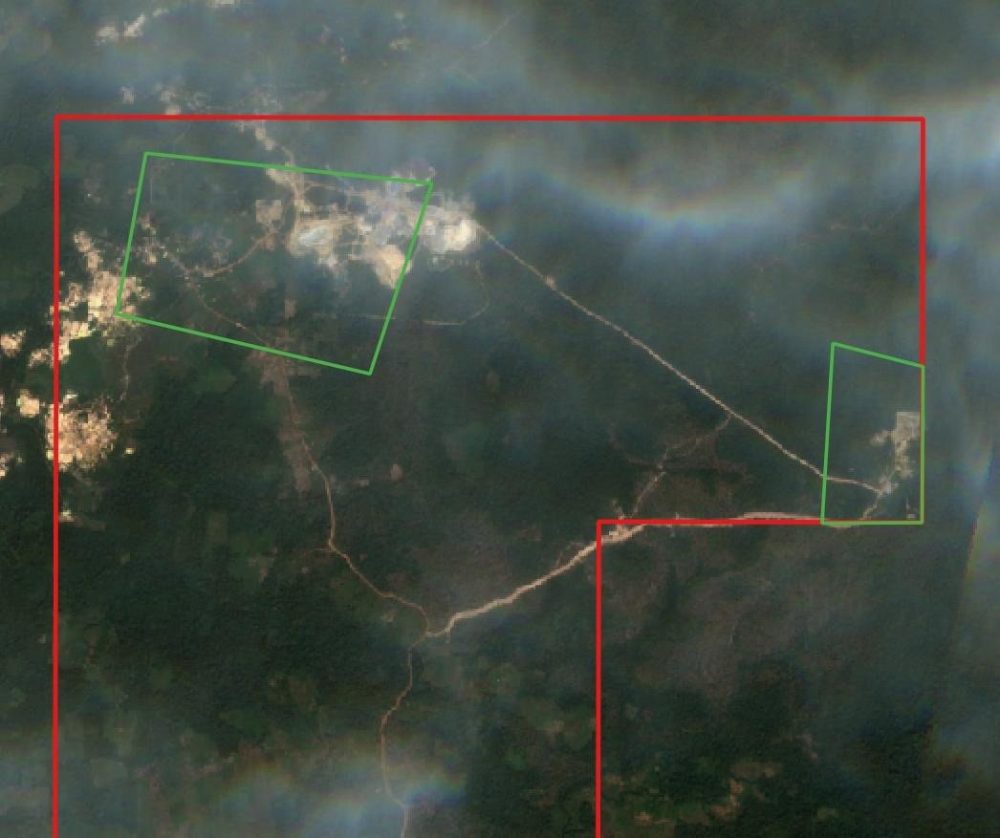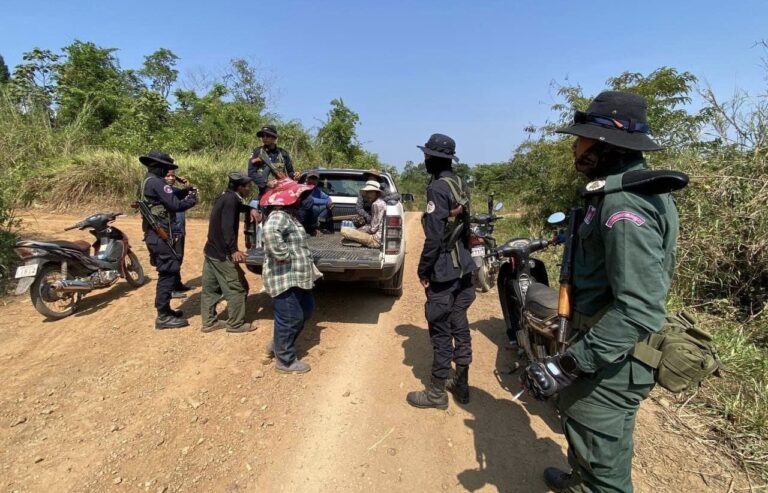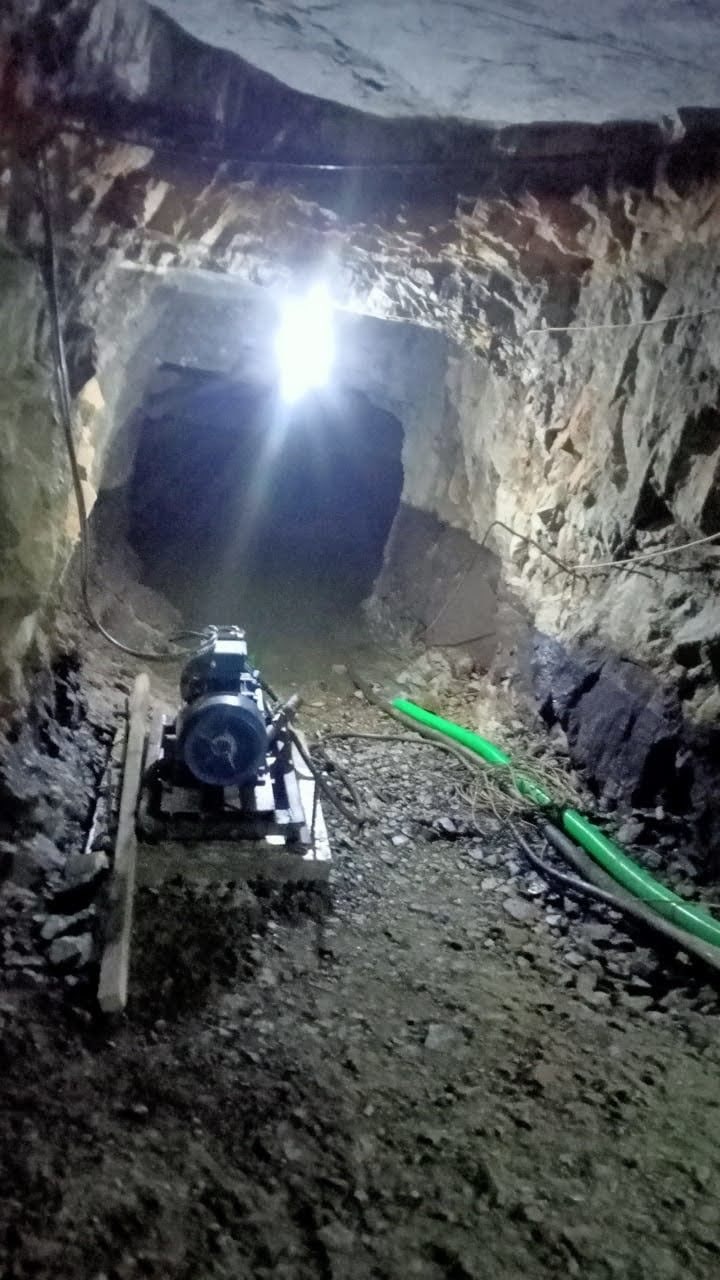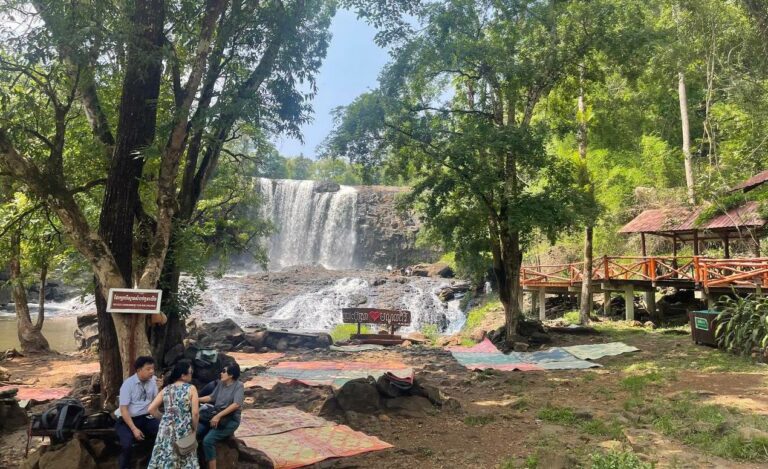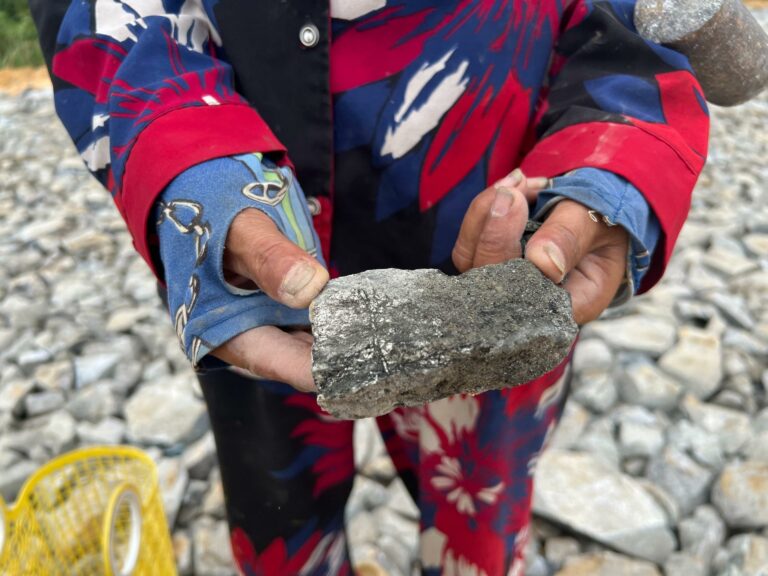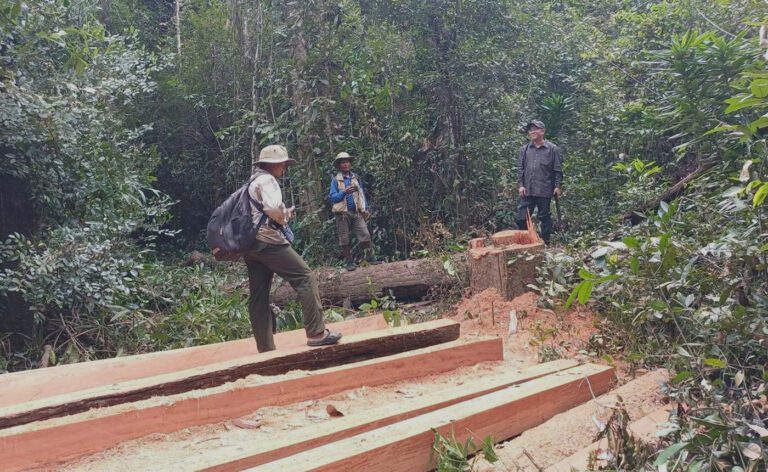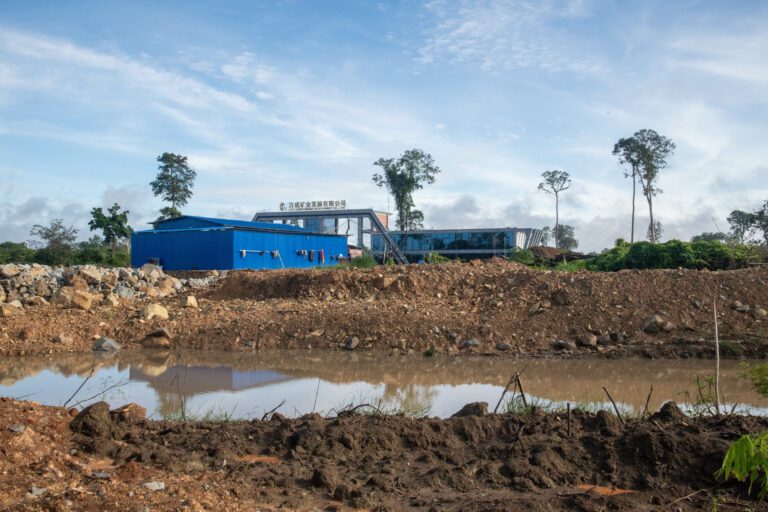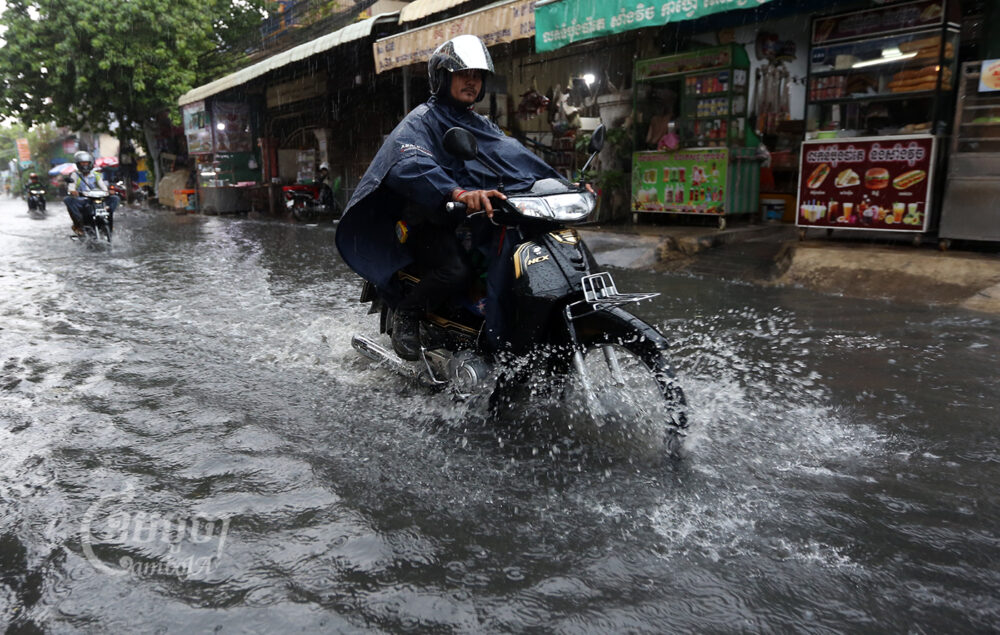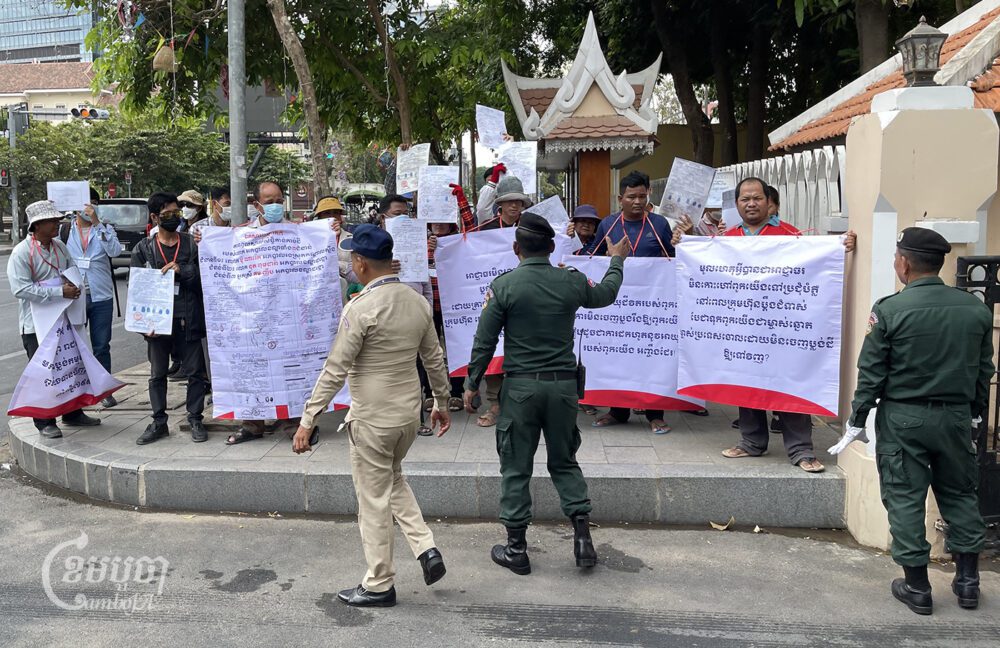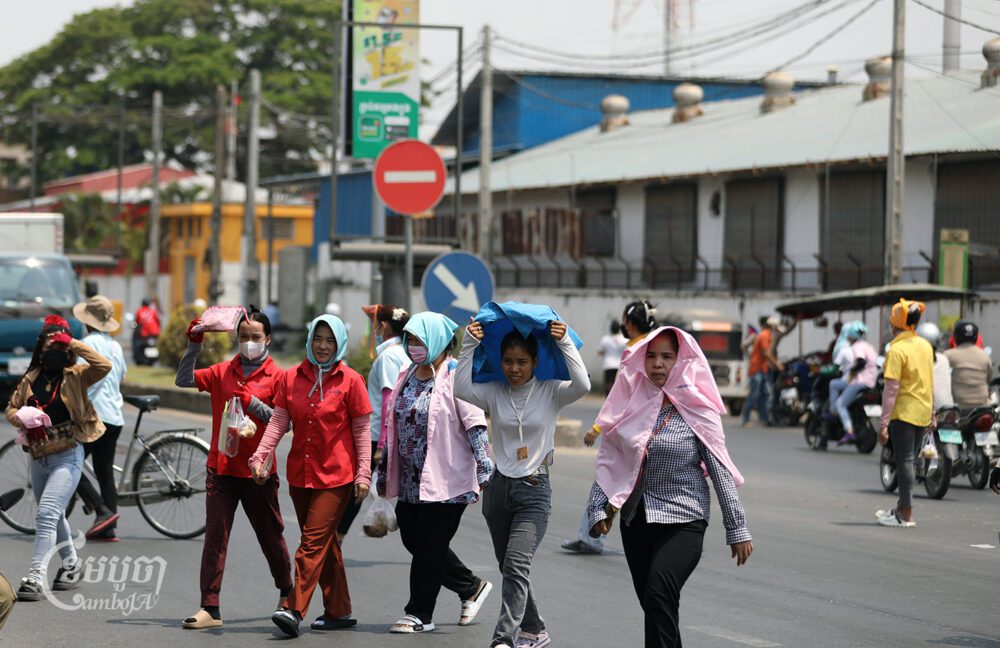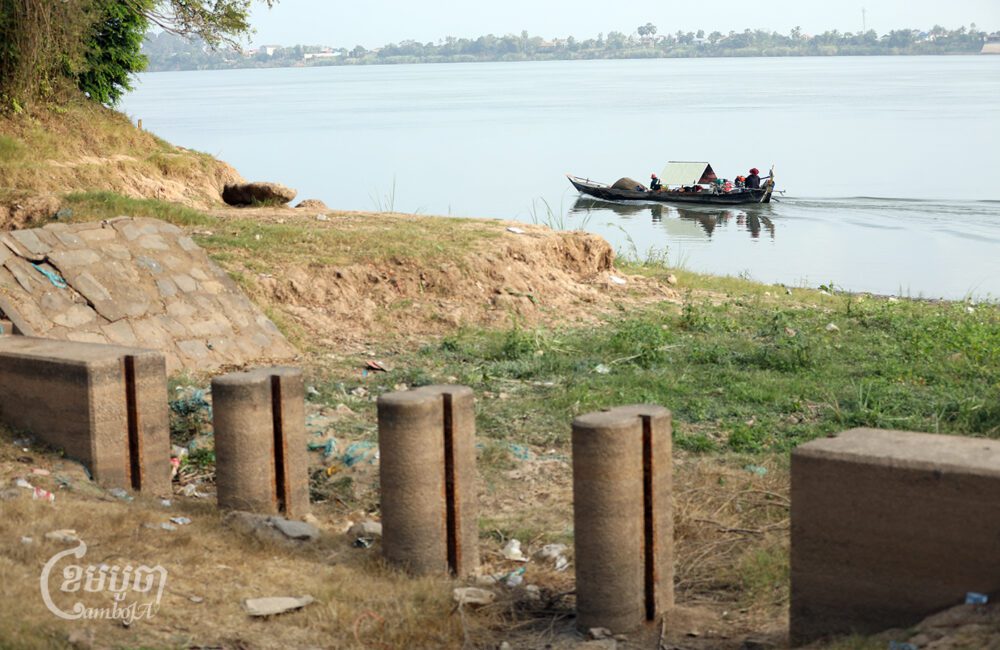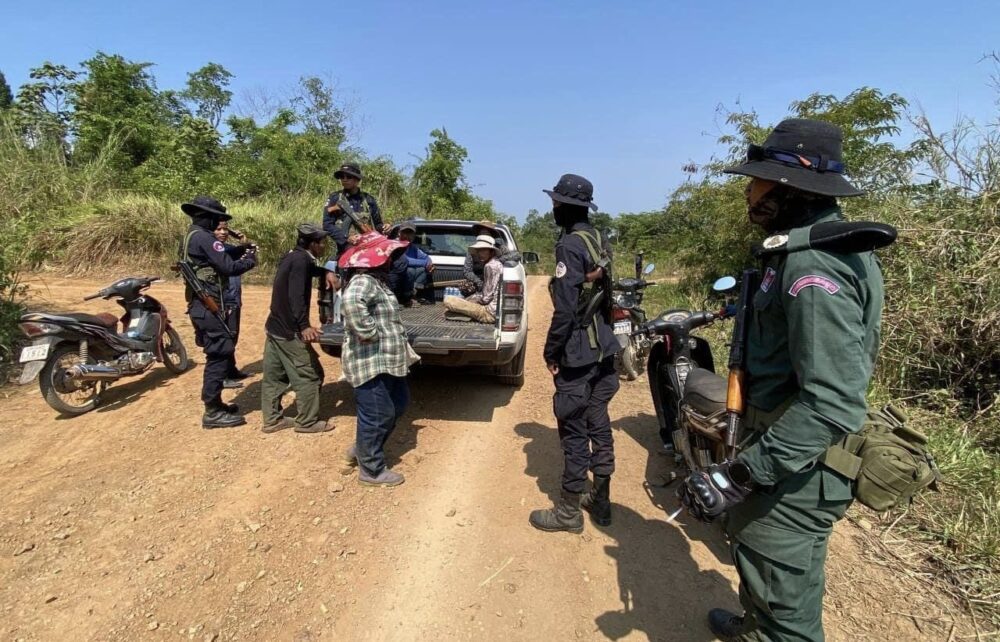Kampong Thom’s Sandan district: Snang An village chief Sok Heng proudly displays a photo of his new home, constructed in July 2021, as his phone’s background image. But Late Cheng Mining Development, a gold mining firm with ties to Prime Minister Hun Sen’s bodyguard unit, now threatens to dismantle the home and has taken over his neighbors’ farmlands, he says.
Heng refused Late Cheng’s offer of $1,000 to remove his home, believing it remains rightfully his.
“I was opposed,” said Heng, who pointed out that the company arrived long after he and his neighbors. “They have no right to prevent my people [from being there]. As they [Late Cheng] give small compensation, I won’t go anywhere.”

Heng and his family have lived on and farmed five hectares of land in the Sochet commune of Kampong Thom’s Sandan district, near tourist-destination Phnom Chi mountain, for nearly 20 years.
Neither Heng nor the approximately 150 families in the area have government-issued land titles for their homes and farms. Their village remains unrecognized because it is located inside the protected area of Prey Lang Wildlife Sanctuary, according to Sochet commune chief Prak Min.
Yet the land’s conservation status did not stop the Council for the Development of Cambodia from legally granting commercial exploitation rights on August 31 to Late Cheng. Mining can be allowed in protected areas if regulations such as an environmental impact assessment are followed. The company’s operations encompass 5,800 hectares, according to a map from an environmental impact assessment seen by CamboJA.
The Ministry of Mines and Energy had previously issued a permit for the company to explore 15,100 hectares in March 2020, mostly inside the Prey Lang Wildlife Sanctuary.
The $13 million Late Cheng project is expected to produce 180 kilograms of gold per year beginning in August 2023, according to the Council for the Development of Cambodia. Late Cheng plans to provide the government with $250,000 annually in royalties, according to Ministry of Mines and Energy director general for mineral resources, Ung Dipola, as quoted in Cambodianess. (Dipola did not respond to requests for comment from CamboJA).
Another gold mining company connected to Late Cheng, Cambodia K88 Industry Co. Ltd, received “metallic mineral exploration” approval in 2020 in an area adjacent to Late Cheng’s concession, comprising 9,394 hectares. Ministry of Commerce records show the company is run by Chun You, who serves as Ministry of National Defense General Department of Technical Equipment Deputy Director, according to rights group Licadho.
While the Prey Lang Wildlife Sanctuary technically covers 431,683 hectares of protected forest, it has been plagued by illegal logging for years. An estimated 11,200 hectares of forest were lost in 2021, the highest rate on record according to data from Global Forest Watch. Citing inadequate government response to persistent, organized mass illegal logging and persecution of local activists, USAID cut its funding to government programs working in the area last June.
Almost no communities in or around Prey Lang have formal land titles, said Courtney Work, an anthropologist of forest landscapes and professor at National Chengchi university in Taiwan. Prey Lang’s protected areas have yet to be zoned, which could allow some communities to receive land titles.
Once land is given to a company, however, those residing in the concession areas often lose all their swidden agricultural land but are generally able to keep their homes or small rice fields, she added.
“Tenure insecurity remains an issue, especially for villagers inside the protected area,” Work said. “Companies always seem to take precedence.”

Opaque environmental impact assessments
In the past few months, as Late Cheng appeared to gear up operations, at least 20 families were blocked from accessing their farmlands and engaging in artisanal gold mining, according to Snang An villagers.
The company has also begun to clear and occupy large swaths of land without sharing its environmental impact assessment publicly or offering fair compensation for their losses, residents say.
At a barbeque stand around the corner from Late Cheng’s entrance, Heng shared photos from his phone of a chemical pool, appearing separated from the earth by only a tarp layer. Heng said it was one of approximately 10 pools used in Late Cheng’s operations.

He said he feared for the community’s health if the chemicals contaminated the surrounding groundwater. The process of extracting gold typically involves leaching the mineral from ore using liquid cyanide and can have severe consequences if improperly stored. In 2018, chemical run-off from gold mining operations in Kratie and Mondulkiri provinces was believed to be responsible for the deaths of more than a dozen people and poisoning of hundreds more.
Environment Ministry spokesperson Neth Pheaktra told CamboJA that Late Cheng and K88 each conducted environmental-social impact assessments but would not provide more specific information or share the results of the assessments. He asserted both companies were legally operating inside the protected Prey Lang Wildlife Sanctuary.
“In case of any impact from the implementation of the project, they [the companies] should make specific reports to authorities for resolving the problem,” he said.
In contrast to Australian-owned gold mining firm Renaissance Minerals, which while disrupting local livelihoods has also published detailed information about its operations and environmental assessments on its website, the operations and impact of Late Cheng and K88 remain opaque.
Maps seen by CamboJA outlining Late Cheng’s projected operations indicate a Chinese-run company called Green Balance Environmental Consulting Co., Ltd. conducted an assessment, but the company did not respond to requests for comment.

The maps show Late Cheng appears to have divided its operation sites within three zones: one located near Snang An village, another in the Damnak Krasaing region, and a third in the Phnom Chi area. Satellite images show signs of mining in these areas but the company’s operations appear to extend outwards beyond these sites as well.
According to a 2009 government order, companies must consult with “Project Affected Persons” when conducting an environmental impact assessment, but Snang An village chief Heng and four other families impacted by Late Cheng operations say this never happened.
Well-connected investors
In November, when CamboJA reporters visited, police guarded the dirt roads leading into both K88 and Late Cheng’s concessions, the entrances cut off by a boom gate. They are led by Major General Keo Thou, a member of the bodyguard unit, which helps guard the companies’ operations, according to village chief Heng.
“The community is not allowed to enter without agreement from the company,” said a uniformed police officer at the Late Cheng checkpoint, who declined to provide his name and prevented CamboJA reporters from entering. A police officer posted near K88 said he would get in trouble if journalists entered without permission.
While the bodyguard unit head Hing Bunheang did not respond to requests for comment, National Police spokesperson Chhay Kim Khoeun said if a company has a license to legally operate it can request security protection.
“This is a measure we have planned to protect our investors,” he said. “It isn’t private issues but investors who have legal operations.”
The mining companies’ investors are particularly well connected.
Ministry of Commerce records for Late Cheng list Pao Kai Jie, Pov Yi Shang, Pov Shang Bin and Soeun Pisey as board directors and Pisey’s Chinese national husband Zhao Ying Ming as chairman.
Ying Ming and K88 director Chun You, the Ministry of National Defense official, are connected as co-directors of Phnom Penh Zhe Long Mining Development Co., Ltd. and Phnom Penh Zhe Long Construction Development Co. Ltd.
Through donations, Zhao and Pisey have reinforced connections to Cambodia’s ruling elite and military and local law enforcement officials.
Facebook posts include the couple posing in September with bodyguard unit head Hing Bunheang and General Hun Manet, the Prime Minister’s son and heir apparent of the ruling Cambodian People’s Party.
“May the New Year Angel take care of Mr. Zhao Ying Ming and his wife Soeun Pisey and their children to meet the four blessings of the Buddha: age, class, happiness, and strength,” wrote Kampong Thom deputy police chief Keng Vanny on his Facebook page following a $500 donation in September.
In April, Late Cheng donated $50,000 to the Cambodia Red Cross, run by the Prime Minister’s wife Bun Rany, to commemorate the 159th anniversary of the World Red Cross, according to a Facebook post from the organization. The previous year the company directly donated $3,000.
Since at least 2021, Late Cheng provided medical supplies to the Kampong Thom Region 4 military and covered construction costs of Kampong Thom police facilities, including a $10,000 donation in April.
None of Late Cheng or K88’s directors responded to requests for comment.

Impact on REDD+ project?
Gold mining ventures like Late Cheng and K88 are also deforestation drivers, said Conservation International Cambodia country director Sony Oum.
That raises questions about the potential impact the mines may have on plans to expand a Conservation International “Reducing Emissions from Deforestation and forest Degradation” (REDD+) project in the area. REDD+ allows companies to pay to protect forests as a way to offset their carbon emissions, with the project heralded by some as a way to monetize the long-term conservation of Cambodia’s remaining forests.
Conservation International, alongside the Ministry of Environment and Japan’s Mitsui Banking corporation, seeks to implement a REDD+ project in the Prey Lang sanctuary, which has already been affected by deforestation linked to a new limestone mining concession and plans for a high power transmission line.
While the gold mining companies’ operations do not overlap with the current REDD+ project in the Stung Treng province section of Prey Lang Wildlife Sanctuary, the REDD+ project is expanding into Kratie and Kampong Thom — areas of Prey Lang in which K88 and Late Cheng operate. The REDD+ boundaries have not been confirmed as “project sites and targeted communities are being identified and validated,” Oum said in a written statement.
“We are working closely with the government to minimize any impacts it could have on the [REDD+] project and maximize the benefits for sustainable development for the country as well as balance conservation and development outcomes,” he added. “As it is still in the design or feasibility phase, it is too early to say how, if at all, the mining will impact the project site.”
Restricted access to land
Most Snang An villagers came to Prey Lang in the 1990s or early 2000s, seeking land and economic opportunity. Many attempted artisanal gold-mining, which can involve planning and pumping out gold or even using cyanide as filtration, and larger scale unregulated and unlicensed mining operations proliferated at times.

Swaths of trees died as a result of contamination from gold mining around Prey Lang in Kratie and Kampong Thom as local officials were bribed to look the other way, the Phnom Penh Post reported in 2012. Yet illegal logging operations have had a far greater impact on the forest landscape.
Seeking to receive recognition of their longstanding presence, the Snang An community applied to the Interior Ministry to become an official village in 2018.
But director-general of the Ministry’s General Administration Department, Prak Sam Oeun, claimed the ministry had not yet seen this request.
Snang An pagoda committee chief Pes Piseth, a 62-year-old former soldier with Son Sann’s guerilla forces, said as a result of Late Cheng’s operations he can no longer access the four hectares he has cultivated since arriving in the area in the early 1990s after leaving the Site Two refugee camp. Villagers are concerned because the company has blocked them from accessing farms in the red dirt road leading into the forest.
“This road was built by villagers in the village, and when they [Late Cheng and K88] came, they started to block the road,” Mr. Piseth said. “[Villagers] are not allowed to access [company sites], even company workers are not easily able to come out to stay at home.”

His neighbors, Lach Un, 60, and husband Sen On, 61, say they have been living in the area for nearly three decades and were told by Late Cheng they could no longer use power tillers to plow their four hectares of land. The company also barred artisanal mining, though some families have been able to sign contracts to continue doing shallow mining but must stop when the company orders, according to images of two contracts viewed by CamboJA.
“To start from this year, we are not allowed to grow crops but can plant rice paddy and I don’t know next year,” Un said. “Even though I have farmland over there [inside the Late Cheng zone] they have restricted us from going inside.”
“If we can’t do rice farming, we will go to work picking cashew nuts and collecting cassava,” On added.
Their neighbor, Som Sam, 61, said she came to permanently live in Sochet commune in the 2000s and cultivated crops on 10 hectares of land. Two years ago, Late Cheng excavators destroyed all but three hectares.
“When they occupied our land, they gave only $100, and when we went to stop them, they didn’t listen,” Sam said. “They have banned us from planting big crops like cashew nut trees.”
Without nationally-recognized land titles, residents in the area have little legal recourse for the loss of their land and farms. Chief of an unofficial village, Heng lamented what he considered the lack of accountability governing the companies’ activities.
“They [the companies] have used their power to do whatever they want, no one dares to stop them,” he said. “They have cleared land and forest, no one can prevent it.”
Correction: An earlier version of this article mistakenly listed Dong Shuangyong, Feng Zhirong, Yin Guozhong as board directors for Late Cheng. In fact, Commerce Ministry records list them as board directors of Phnom Penh Zhe Long Construction Development Co., Ltd. Yin and Feng are also listed as board directors of Phnom Penh Zhe Long Mining Development Co., Ltd.


